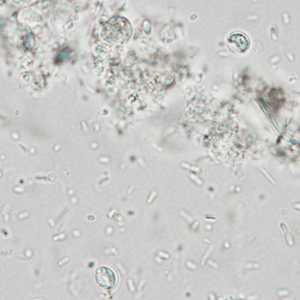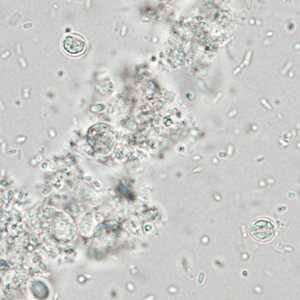
Case #337 - December, 2012
A five-year-old boy developed loose, watery stools approximately one week after attending a birthday party for a friend. The parents took the child to their health care provider for medical attention. The parents told the physician that at the party, the child played in splash pads. A stool specimen was collected in 10% formalin and submitted for laboratory testing. A formalin-ethyl acetate concentration was performed and a wet mount of the sediment was examined for ova and parasites. Objects shown in Figures A and B, measuring 5-6 micrometers on average, were observed in moderate numbers at 1000x magnification. The laboratory recommended to the attending physician that a modified acid-fast stain be done. It was ordered and Figure C shows what was observed. What is your diagnosis? Based on what criteria? What further testing, if any, would you recommend?

Figure A

Figure B

Figure C
Case Answer
This was a case of cryptosporidiosis caused by Cryptosporidium sp. Diagnostic features shown included:
- round, refractile oocysts in the size range consistent with Cryptosporidium sp. (Figures A and B from the unstained wet mount).
- acid-fast stained oocysts within the size range for Cryptosporidium sp. (Figure C).
Unless the parasite density is high, it can be difficult to accurately diagnosis Cryptosporidium in an unstained wet mount. Tests for confirmation of Cryptosporidium may not currently be part of a standard O&P exam so laboratory personnel and physicians should be aware that modified acid-fast smears, direct fluorescent antibody (DFA) assays, enzyme immunoassays (EIA), or PCR are well validated procedures that can be used for a definitive identification of Cryptosporidium. PCR methods can be used to determine the species of Cryptosporidium which may be useful in outbreaks investigations.
More on: Cryptosporidiosis
Images presented in the monthly case studies are from specimens submitted for diagnosis or archiving. On rare occasions, clinical histories given may be partly fictitious.
DPDx is an education resource designed for health professionals and laboratory scientists. For an overview including prevention and control visit www.cdc.gov/parasites/.
- Page last reviewed: August 24, 2016
- Page last updated: August 24, 2016
- Content source:
- Global Health – Division of Parasitic Diseases and Malaria
- Notice: Linking to a non-federal site does not constitute an endorsement by HHS, CDC or any of its employees of the sponsors or the information and products presented on the site.
- Maintained By:


 ShareCompartir
ShareCompartir